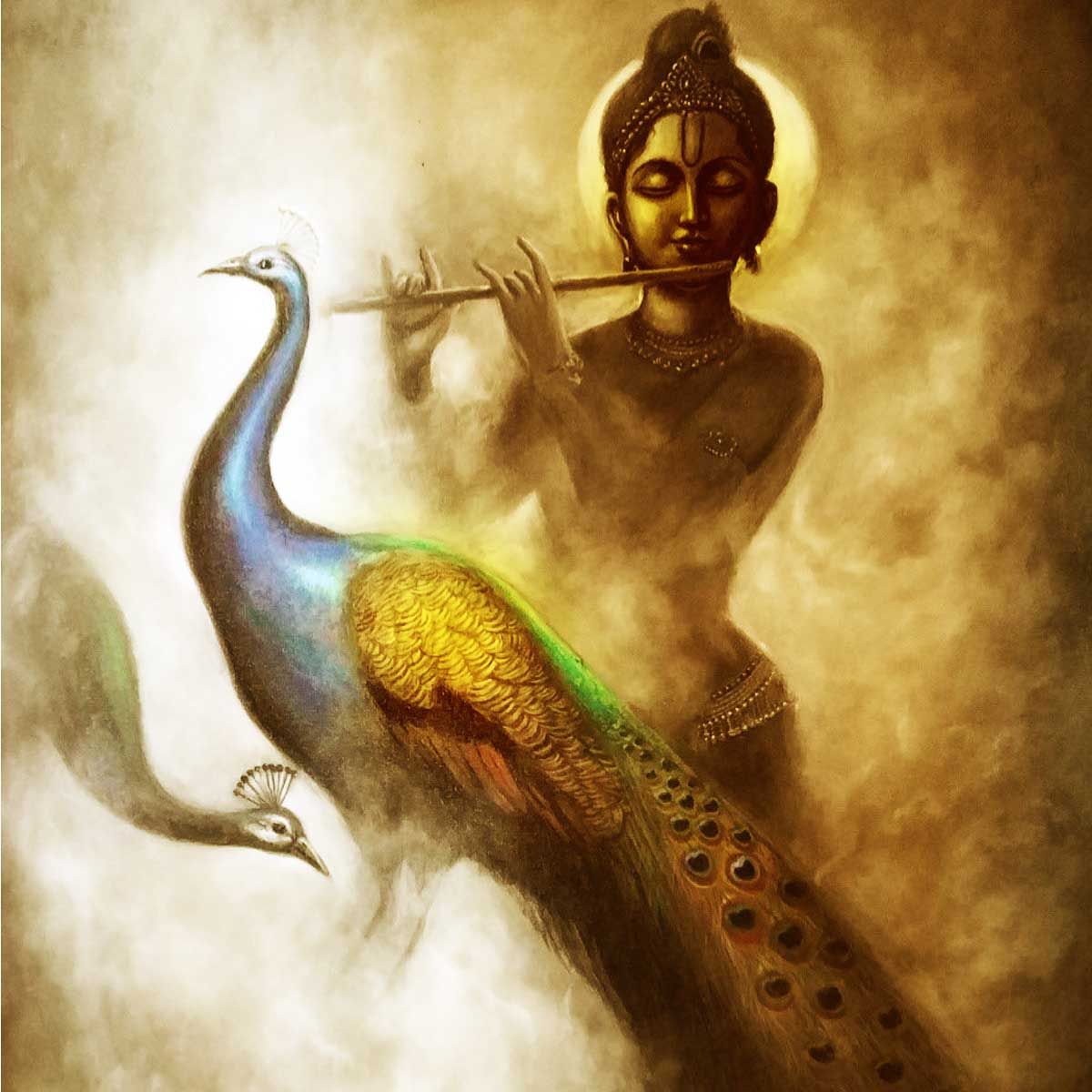MORE COVERAGE
Sanãtana Dharma Versus Prophetic Creeds - Defence of Hindu Society

The one Vedic verse that modern Hindus quote most frequently is the third quarter of Rigveda 1.164.46 Ekam sad viprãh bahudhã vadanti (it is of One Existence that the wise ones speak in diverse ways).
The full mantra reads as follows:
Indram mitram varuNam agnim ãhuh,
atho divyah sa suparNo garutmãn,
ekam sad viprãh bahudhã vadanti,
agnim yamam mãtarivãnam ãhuh
(They hail Him as Indra, as Mitra, as VaruNa, as Agni, also as that divine and noble-winged Garutmãn. It is of One Existence that the wise ones speak in diverse ways, whether as Agni, or as Yama, or as Mãtarivãn.)
Why do modern Hindus quote only one-fourth and not the whole mantra? Why do they forget or refuse to cite the rest of it, or at least consider three-fourths of it as irrelevant or superfluous? And why do they assign disproportionate weight to just one word, ekam, out of the five words which comprise what they consider to be the weighty one-fourth?
A careful reading of the full mantra, particularly in the context of the sûkta of which it is a part, leaves no doubt that the three-fourths which is ignored is not at all a repetition or paraphrase of the one-fourth which is presented. On the contrary, that three-fourth is as significant, if not more, as the one-fourth when we take into account the spirit of the Veda from which the citation has been selected. In fact, the one-fourth which is flourished so forcefully remains meaningless unless it is read with the rest of the mantra.
Why do modern Hindus maim in this manner a mantra from what they hold as their most sacred shastra? What do they want to prove by this wanton misrepresentation of an entire and ancient ethos in spirituality, philosophy, and culture?
The answer becomes obvious as soon as we look into the psychology behind the citation.
 |
Hindu Psychology of Surrender
Firstly, modern Hindus want to stake a claim for admission to the exclusive club of Monotheism maintained by Christianity and Islam. Hindus here are out to convince the monopolizes of monotheism that the earliest Hindu shastra, the Rigveda, also supports and sanctions what is supposed to be the summum bonum of religion according to Christian and Muslim theology, or its apotheosis according to the modern Western Science of Comparative Religion. At the same time, there is an almost pathetic appeal to the monopolizes of Monotheism that they should not be appalled by the multiplicity of gods and goddesses in the post-Vedic Hindu pantheon and that they should judge Hinduism in terms of the original aspiration rather than in terms of the latter-day aberration.
Secondly, modern Hindus are pleading before the custodians of the only true creeds that Hinduism is only a different way of stating the same truths which were revealed to the founders of the former. In effect, Hindus are praying with folded hands, Please do not denounce Hinduism as polytheism, pantheism, idolatry, paganism, and kufr. Please ignore the differences in language and metaphor, and attend to the fundamental spirit which informs your faiths as well as ours.
The Hindu psychology throughout this exercise is one of apology, of shamefacedness, of defense against what is initially conceded as a valid criticism of the idioms and forms in which Hindu spirituality has been spelled out in its shastras. This is disastrous psychology. It leads to a supine surrender on the one hand, and to a slavish invitation on the other.
The psychology of surrender is best symbolised by the well-intentioned Hindu slogan of sarva-dharma-samabhãva when it is extended indiscriminately to Christianity and Islam. Hindus are shouting themselves hoarse in stressing the identity of Brahma with Abraham, of Manu with Noah, of Rama with Rahim, of Krishna with Karim, of Kashi with Kaba, and so on. But the monopolises of Monotheism remain far from mollified. The orthodox among the monotheists dismiss with contempt the Hindu claim of sharing the same faith with them fundamentally. The kinder (or craftier) among the monotheists take pity on this plight of poor Hindus, and invite them to renounce their nebulous, if not counterfeit, Monotheism in favour of the fully developed doctrine.
Hindu Psychology of Imitation
The psychology of imitation is manifest in modern Sikh scholars who have, over the years, forced the message of the great Gurus into monotheistic moulds. They have almost succeeded in eclipsing, more or less completely, the Upanishadic spirituality of the nirguNa saints among whom Guru Nanak occupies the front rank. They take immense pride in equating the Ek 2Mkãr with Allah, the Ãdigrantha with Al-Kitãb, the succession of Sikh gurus with the succession of prophets in which Guru Gobind Singh is the last like Muhammad, and the injunctions of the last Guru regarding outer symbols with similar injunctions of the Sunnah.
A manifestation of the Islamic spirit could not lag far behind, once Sikhism started Islamicizing itself. It has progressed on the path of a similar exclusiveness, a similar self-righteousness, similar self-aggrandizement, similar use of terror in the service of religion, and a similar mob mentality vis-a-vis internal dissent, as have characterized Islam throughout its blood-soaked career. Sikhism is fast moving out of its spiritual moorings and becoming a politics of power which Islam has always been.
The way out
Hindu society will never be able to combat or come to terms with the only true creeds like Christianity and Islam, so long as its spokesmen continue to clothe Hindu spirituality in concepts borrowed from Monotheism. The slogan of sarva-dharma samabhãva will fail to make any dent in the armour of Christian and Muslim animosity, so long as Hindus fail to recapture the spirit and the context in which this slogan had been evolved.
What, then, is the way out?
Firstly, Hindus have to reawaken to the sublime spirituality of their own Sanãtana Dharma, and base their evaluation of other religions and cultures on its pristine premises. That will give them the requisite self-confidence to counter all misinformed or malicious criticism.
Secondly, Hindus have to study and scrutinise the sources from which the only true creeds derive their inspiration. That will invest Hindus with an insight into why the monopolises of Monotheism have always been so impervious to appeals for goodwill and understanding among different sections of the human family.
The fundamental difference between the Sanãtana Dharma family of faiths on the one hand, and the only true creeds like Christianity and Islam on the other, can be drawn out in the form of a dialogue between a Soviet citizen and a citizen from a free society. The story may not be literally true. But it is illustrative of what can happen to human mind when it is deprived of freedom, and is regimented by blind beliefs imposed from outside.
 |
A free society Versus A closed Fraternity
A Soviet diplomat arrived in the capital of a democratic country on a commercial mission on behalf of his government. The mission was to continue for several months, and the hotel in which the diplomat had to stay immediately on his arrival was rather expensive by Soviet standards. Next day, the diplomat approached the enquiry counter of the hotel and asked the lady in attendance, Where can I find your Housing Committee?
The lady could not understand his question and asked him to elaborate. The diplomat explained, You see, I cannot stay for long in this expensive place. I want to apply to the appropriate authority for allotment of adequate but cheaper accommodation.
The lady picked up the telephone directory, opened it at a particular page, and told the diplomat, Sorry, we have no such committee in this city or anywhere else in this country. You have to go to an estate agent who will show you all kinds of accommodation and negotiate for the one you approve of finally. The leading estate agents are listed on this page. You may phone to any one of them for an appointment.
The diplomat was visibly annoyed. He shoved aside the telephone directory and shot his next question, And where can I find your Food Committee?
The lady informed him that there was no such committee either. The diplomat was now furious. He shouted, How and where, then, do I buy the food which I will need every day? I must have the necessary permit.
The lady assured him patiently that he needed no permit, and that he could go into any of the hundreds of stores to buy whatever he wanted, whenever he wanted.
By now the diplomat was in tantrums. He taunted; I suppose you have no Transport Committee either?
The lady kept her cool and said with a smile, Why, there are all those taxies standing and cruising all over this city. You can hire any one of them at any time of the day or night and go wherever you please.1
The diplomat gave up in utter disgust. There was sadness writ large on his face. He shook his head several times and said to himself, Very bad! Very bad indeed! There is no system in this country. It is a chaos all around. I feel lost.
Spiritual freedom Versus Religious Regimentation
A follower of closed creeds like Christianity and Islam finds himself in a similar situation when faced with the spiritual freedom that is Sanãtana Dharma. He discovers very soon that Sanãtana Dharma does not fit into any of the mental moulds to which he is wedded, and which he seeks in other systems of thought. He is most likely to shake his head in utter disgust and feel lost like our diplomat from a closed social system stationed in the metropolis of a free society. An encounter between a monotheist and an informed follower of Sanãtana Dharma is, therefore, sure to develop along similar lines.
The first point in which the followers of closed creeds take great pride is the historicity of the only saviour or the last prophet who was sent by or who received the full and final revelation from the one and only true god. The first question which such a faithful will put to a student of Sanãtana Dharma, therefore, is bound to be as follows: Who is your only saviour or your last prophet? Where was he born and brought up? Where and when and before which apostles or companions did, he teach, preach, and reveal?
 |
A student of Sanãtana Dharma cannot but reply as follows: The very concept of a historical saviour or prophet is foreign to Sanãtana Dharma. We do not concede the monopoly of spiritual truth or moral virtue to any historical person, howsoever great or highly honoured. Everyone has to be one’s own saviour, one’s own prophet. One has to discover the spiritual truths for one’s own self, if that truth has to have any meaning for one or any validity in one’s life. A truth discovered by someone else cannot become my truth unless I rediscover it for myself. Scriptures and spiritual teachers can be my aids and guides, and may help me in my search for truth. But the truth of which the scriptures speak or which the teachers expound cannot become a truth for me unless it comes alive in my own consciousness, and starts transforming my own life. Moreover, the very historicity in which you take pride is for us the hallmark of the ephemeral and the false. We reject a historical religion as pauruSeya prasthãna, idiosyncrasies of a particular person, no matter how you hail him. That which was born in history has also died in history. You are showing devotion to what is dead and gone.
Next, the followers of closed creeds are mighty proud of being as Ahl-i- Kitãb or the People of the Book. They are sure that the only true revelation from the one and only true god is contained in the book (al-kitãb) which was compiled by the apostles of the only saviour or the companions of the last prophet, after the saviour or the prophet had passed away and could speak no more. They believe that nothing can be taken out from or added to this book which is supposed to contain the final truth for all time to come. Therefore, the second question which such a faithful will put to a follower of Sanãtana Dharma is as follows: Which is the book in which you believe, or your al-kitãb?
A student of Sanãtana Dharma is sure to reply as follows: What for do we need a book? The whole spiritual truth, every shastra, is secret in the human heart. Anyone, anywhere, at any time can have access to the spiritual realm provided one seeks for it sincerely, and prepares oneself for entering it. Many seers and saints have seen it in as many ways, spoken of it and in as many languages and by means of as many metaphors. The Vedas provide one version of it, the Jainãgama another, the TripiTaka yet another, and so on down to the latest Hindu saint such as Sri Ramakrishna, or the latest Hindu sage such as Raman Maharshi. Different sects of Sanãtana Dharma have collected the sayings and songs of different sages and saints in as many books which these sects cherish as their shastras. But these shastras are not at all what you describe as the book or al-kitãb, even by distant definition. Your creed will get lost for good if your book or al- kitãb gets lost. The book or al-kitãb cannot be recovered because the person who preached it or to whom it was revealed is dead and gone. But Sanãtana Dharma will lose nothing if all its shastras are lost. All old shastras and many more can be recovered from inside the human heart, where all of them are ultimately enshrined.
By now the follower of a closed creed is most likely to feel flabbergasted by what he has been brainwashed to regard as blasphemy. The third question that such a faithful will put to a student of Sanãtana Dharma is as follows: You have no only saviour, no last prophet. You have no al-kitãb. How, then, do you know who is your one and only true God? How do you distinguish this one and only true god from the many false gods which abound all around you?
At this stage the student of Sanãtana Dharma will have to smile and say, according to our spiritual tradition, testified by a long line of spiritual seekers, the way to God-discovery is through Self-discovery. As one proceeds on that inner voyage, one sees spiritual truths in many forms. None of these forms is false. It is only ones seeking that can falter and lead to one fall from the path of spiritual progress by insisting that this or that form alone is true.
Sanãtana Dharma stands squarely for a human becoming God in the process of Self-discovery - Ãtman becoming Parmãtman, PuruSa becoming PuruSottama . This is the path of world-discovery as well. The deeper one dives into oneself, the faster one’s world gets divinised. One start seeing God in every human being, in every animal, in every plant, in every stone. One feels free to worship God in any from or in all forms at the same time. One also feels free not to worship God at all, and to dwell within oneself in spiritual self-delight. Sanãtana Dharma, therefore, has no use for a God who makes himself known to mankind through the medium of a saviour or a prophet, or through the pages of al-kitãb or the book. Such a God must always remain external to us, and external to the world in which we live. Such a God does not permit humanhood to grow into Godhood, nor allows this world to get divinised. He has reserved all divinity for himself, and has nothing to spare for his creatures except an abject servitude to his arbitrary commandments conveyed through a saviour or a prophet chosen equally arbitrarily.
The follower of a closed creed now shoots the last arrow in his armory with what he believes to be a deadly effect. He is sure to shout, You have failed to win the favour of the only saviour or the last prophet by not living a life according to the final commandments of the one and only true God as revealed to his only son or his last prophet in al-kitab or the book. How will the only saviour or the last prophet intercede for you on the Day of Judgement, and save you from God's wrath and eternal hell-fire? You cannot say in all seriousness that you are not interested in going to eternal heaven full of fair maidens, flowing with milk and honey, and fanned by ever-fragrant breezes.
A student of Sanãtana Dharma will keep his cool and reply as follows: Sanãtana Dharma is not so mean and miserly in deciding human destiny. It gives many lives to every creature. One can start anew from the point where one stopped in one’s previous life. And the process does not cease till a creature has attained perfection and achieved Godhood. Everyone is a bodhisattva destined to become the Buddha in the course of spiritual seeking. The journey is from darkness and bondage to light and freedom, and not from the sensual pleasures of this world to the sensual orgies of high heaven. On the other hand, the only hell we know is neither situated outside ourselves nor at the end of time. The hell is within us - in our greed and gluttony, in our hatreds and infatuations, in our self-righteousness and self-seeking, in our dark drives for power and domination, in our self-love and pursuit of pleasure. The only way out of this hell is through an awakening to the divinity within us, and through dispelling the darkness of ignorance in which we live our mundane lives. The favour or disfavour of a saviour or a prophet can neither catapult us into heaven nor drag us down into hell. A saviour or prophet is absolutely irrelevant to the realm of spiritual progress or retrogression.
At this point the follower of a closed creed is bound to give up in utter disgust. He is bound to exclaim, Very bad! Very bad indeed! There is no system in your bewildered beliefs. It is a free for all. What is worse, it is blasphemy against the one and only true God, against the only saviour or the last prophet sent by Him, and against the only true revelation conveyed by Him through a mighty messenger.
 |
Psychology of Closed Creeds
A student of Sanãtana Dharma can ignore these pronouncements and proceed to examine the only true creeds. To start with, he will not judge these creeds for their inner logic or want of it, but instead, weigh them on the scales of yogic spirituality systematized by reflective reason. And he will very soon find out that these creeds are not born of a spiritual consciousness at all. On the contrary, they are constructs of the outer mind drawing strength from dark drives of the unregenerate unconscious which Freud and other psychoanalysts have studied and surveyed with some insight.
The one and the only true god of these creeds is the embodiment of fear and awe of the dark and the unknown. Their only saviour or last prophet is a father figure in an infantile search for security in a world full of doubts and uncertainties. Their al-kitãb is a collection of rationalizations mounted upon human passions like self-love, jealousy, vindictiveness, cunning, covetousness, and aggression. Their heaven represents an explosion of the animal hunger for endless sense-pleasures unmixed with or followed by pain. Their hell symbolizes a deep-seated hatred for fellow human beings who refuse to bow down before self-appointed messengers of an imaginary almighty.
Hindu society will acquire self-confidence vis-a-vis the only true creeds when it recognizes that Sanãtana Dharma stands for self-exploration, self-purification, and self-transcendence, while these creeds stand for self- stupefaction, self-righteousness, and self-aggrandizement. The horrible histories of these creeds are running commentaries on the character of their doctrines. Those histories are full of crusades and Mihãds, massacres and genocides, inquisitions and witch-huntings, extinction of the freedom of thought and spiritual aspiration, and imperialist aggression against infidels in which the latter religion and culture are destroyed, their properties pillaged, their lands misappropriated, and their men and women and children slaughtered or enslaved. It is a sin to regard them as religion in any sense of the term and to extend samabhãva towards their exclusive and intolerant dogmas. One of the tasks of a resurgent Hindu society will be to rescue those people who have been forced or lured into the folds of these crude and cruel creeds.
Chapters - Defence of Hindu Society (Sita Ram Goel)
- The Situation at Present
- Sanãtana Dharma Versus Prophetic Creeds
- The Spiritual Centre of Hindu Society
- Hindu Spirituality Versus Monotheism
- The Basis of Universal Spirituality
- Revival of Universal Spirituality
Footnotes:
1 This dialogue was written when the Soviet Union was functioning. Now the Soviet Union is no more. But the point made is still valid.
References:
Defence of Hindu Society - Sita Ram Goel - Voice of India, New Delhi
 Support Us
Support Us
Satyagraha was born from the heart of our land, with an undying aim to unveil the true essence of Bharat. It seeks to illuminate the hidden tales of our valiant freedom fighters and the rich chronicles that haven't yet sung their complete melody in the mainstream.
While platforms like NDTV and 'The Wire' effortlessly garner funds under the banner of safeguarding democracy, we at Satyagraha walk a different path. Our strength and resonance come from you. In this journey to weave a stronger Bharat, every little contribution amplifies our voice. Let's come together, contribute as you can, and champion the true spirit of our nation.
Please share the article on other platforms
DISCLAIMER: The author is solely responsible for the views expressed in this article. The author carries the responsibility for citing and/or licensing of images utilized within the text. The website also frequently uses non-commercial images for representational purposes only in line with the article. We are not responsible for the authenticity of such images. If some images have a copyright issue, we request the person/entity to contact us at This email address is being protected from spambots. You need JavaScript enabled to view it. and we will take the necessary actions to resolve the issue.
Related Articles
- The Spiritual Centre of Hindu Society - Defence of Hindu Society
- Dangers of losing our identity: Guru Tegh Bahadur forgotten and Aurangzeb being glorified
- Why India’s temples must be freed from government control
- Hindus documented massacres for 1000s of years: Incomplete but indicative History of Attacks on India from 636 AD
- The Basis of Universal Spirituality - Defence of Hindu Society
- How Chhatrapati Shivaji Maharaj was establishing Hindu Samrajya by concluding centuries of Islamic oppression - Historian GB Mehandale destroys secular propaganda against Hindu Samrajya Divas
- Manyavar commercial featuring Alia Bhatt vilifies Hindu wedding ritual Kanyadaan: Why not object Western practice of ‘giving away the bride’ and Nikah (marriage contract)
- ‘Casteless Hindu’ is Not a Paradox. It is The keystone of ‘Ghar Wapsi’ and Hindutva
- Hindu Spirituality Versus Monotheism - Defence of Hindu Society
- Indonesia: Sukmawati Sukarnoputri, daughter of Indonesia's first president becomes a Hindu leaving Islam














